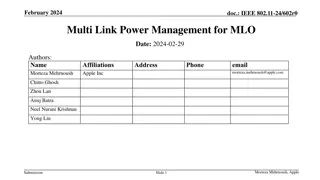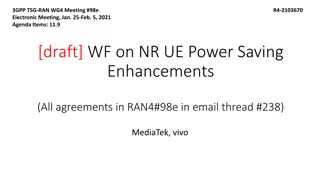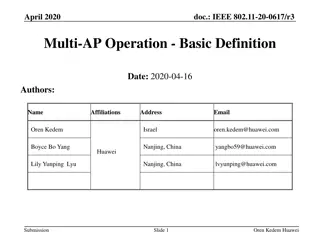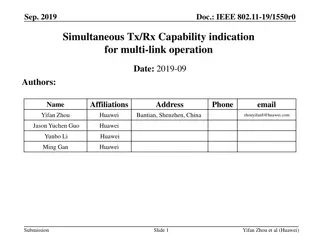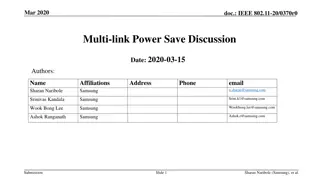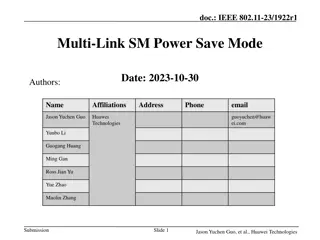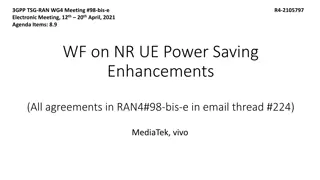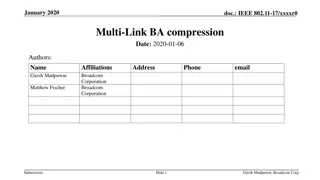
IEEE 802.11-2020 Multi-Link Power Saving Discussion
Explore the IEEE 802.11-2020 document discussing Multi-Link power saving mechanisms for improving efficiency and reducing power consumption in wireless communication networks while enhancing reliability and throughput.
Download Presentation

Please find below an Image/Link to download the presentation.
The content on the website is provided AS IS for your information and personal use only. It may not be sold, licensed, or shared on other websites without obtaining consent from the author. If you encounter any issues during the download, it is possible that the publisher has removed the file from their server.
You are allowed to download the files provided on this website for personal or commercial use, subject to the condition that they are used lawfully. All files are the property of their respective owners.
The content on the website is provided AS IS for your information and personal use only. It may not be sold, licensed, or shared on other websites without obtaining consent from the author.
E N D
Presentation Transcript
2020 doc.: IEEE 802.11-2020/0070r1 Multi-Link Power Saving Discussion Date: 2020-01-11 Authors: Name Affiliation Address Phone Email Yonggang Fang ZTE (TX) yfang@ztetx.com Bo Sun ZTE Zhiqiang Han ZTE Nan Li ZTE Submission 1 Yonggang Fang, etc., ZTE
2020 doc.: IEEE 802.11-2020/0070r1 Abstract This contribution follows up the discussion of EHT multi-link communication to support low latency, high reliability and high throughput applications, and discusses the issue of power consumption in ML operation. It also proposes a possible approach for establishing an anchored link for ML power saving operation. Submission 2 Yonggang Fang, etc., ZTE
2020 doc.: IEEE 802.11-2020/0070r1 Introduction Multi-Link framework requirements In [1], it proposed the ML framework requirements Dynamic selecting and switching an operating link to address the use cases of reducing access latency for fast connection, balancing loads, etc.. Concurrent transmit or receive packets over multiple links to address the use cases of improving transmission reliability and increasing peak-throughput. Utilizing multi-link efficiently for power saving especially for stations. Power consumption issue In [2], it summaries power consumption of 802.11ax devices (single link) the power consumption in the idle mode is 50mA, 60mA and 75mA for bandwidth 20MHz, 40MHz and 80MHz, respectively. the power consumption of receiving mode is 100mA, 140mA and 200mA for bandwidth 20MHz, 40MHz and 80MHz, respectively. In ML operation, the power consumption could be multiple times of a single link s when multiple links are turned on in idle state. Therefore a mechanism is required to address the power consumption issue in ML operation. Submission 3 Yonggang Fang, etc., ZTE
2020 doc.: IEEE 802.11-2020/0070r1 MLD Power Saving Proposal Principle In MLD active operation mode, at least one link of MLs is enabled and in active state when the AP MLD and the non-AP MLD has data to transmit, or the non-AP MLD receives from the AP MLD a message for establishing ML operation. In MLD power saving operation mode Define an anchored link for communication between AP MLD and non-AP MLDs optimize the transmission of groupcast frames, further reduce the power consumption of non-AP MLD, further reduce the overhead of broadcast management frame, e.g. multi-link information may be broadcast only on the anchored link. Submission 4 Yonggang Fang, etc., ZTE
2020 doc.: IEEE 802.11-2020/0070r1 MLD Power Saving Proposal MLD Power Saving Operation Setup AP MLD may optionally designate one or more links as anchor link(s) and ensure all associated non-AP MLDs to be able to anchor on for the power save operation, and broadcast the information of anchored link(s) in Beacon frames. An anchored link may be shared by different non-AP MLDs. A non-AP MLD negotiates with the AP MLD for its anchored link and gets confirmed. If the non-AP MLD is a single-link device, it should anchor on the associated link. AP MLD or non-AP MLD can change the anchored link at anytime. If the AP MLD wants to change anchored link(s), it shall notify non-AP MLDs before the change. If a non-AP MLD wants to its anchored link, it needs to negotiate with the AP MLD for the change and gets confirmed. Submission 5 Yonggang Fang, etc., ZTE
2020 doc.: IEEE 802.11-2020/0070r1 MLD Power Saving Proposal MLD Operation Modes MLD Active Operation (MLD-AO): Non-AP MLD enables one or more links based on the need of ML Operation. MLD Power Saving Operation (MLD-PSO): A non-AP MLD only wake up to receive the buffer state indication in Beacon and the groupcast data on its anchored link. Therefore the non-AP MLD can sleep for a longer time to reduce the power consumption. AP-MLD can wake up other link of non-AP MLD on the anchored link. A MLD can switch its mode between MLD-AO and MLD-PSO Switching Anchored Link A MLD (either AP or non-AP) may switch the anchored link for MLD power saving operation when some case happens such as for load balance or interference avoidance. A MLD may include a new anchored link information for the ML power saving operation in ML switching message exchange. Submission 6 Yonggang Fang, etc., ZTE
2020 doc.: IEEE 802.11-2020/0070r1 MLD Power Saving Proposal Non-AP MLD Link State Non-AP MLD maintains the state of each link of ML. Link-Disabled: This link is disabled for any activity. Link-Enabled: This link is in either MLD active operation or MLD power saving operation Link-Active: This link is in MLD active operation. The non-AP MLD can receive and/or transmit frames over this link at anytime. Link-Awake: This link is in MLD power saving operation. The non-AP MLD can listen the transmission on this link, but not transmit. Link-Doze: This link is in sleep for power saving. The non-AP MLD does not listen or transmit on the link. Power Saving Link Enabled Link-Awake Link-Active Link Disabled Link-Doze Submission 7 Yonggang Fang, etc., ZTE
2020 doc.: IEEE 802.11-2020/0070r1 MLD Power Saving Proposal ML UL transmission Non-AP MLD in MLD-PSO mode can activate one or more non-anchored links at anytime for UL transmissions, i.e. transit the anchored link and/or non-anchored links to the active state for UL transmissions. ML DL transmission AP MLD may send Beacon frames with wake-up indication over the anchored link to wake-up anchored link or non-anchored link(s) of a non-AP MLD in MLD-PSO mode. AP MLD may send other frame to wake up one or more than one link on anchored link. A non-AP MLD in MLD-PSO mode will activate the indicated non-anchored link(s) after receiving the wake-up indication in Beacon frame, i.e. transit the anchored link and/or non-anchored links to the active state for receiving frames from the AP MLD. The non-AP MLD may send a response to notify the AP MLD which link(s) are active. Submission 8 Yonggang Fang, etc., ZTE
2020 doc.: IEEE 802.11-2020/0070r1 Summary In this contribution, we discuss Power consumption issues in ML operation A possible approach to address the power consumption on ML operation. Submission 9 Yonggang Fang, etc., ZTE
2020 doc.: IEEE 802.11-2020/0070r1 Straw Poll Do you support to include the following in SFD ? A non-AP MLD may negotiate with the associated AP MLD a link as the anchored link for the power saving operation. YES/NO/ABS Submission 10 Yonggang Fang, etc., ZTE
2020 doc.: IEEE 802.11-2020/0070r1 References 1. 11-19-1095-00-00be-multi-link-requirement-discussion 2. 11-14-0980-16-00ax-simulation-scenarios Submission 11 Yonggang Fang, etc., ZTE
2020 doc.: IEEE 802.11-2020/0070r1 Thank you! Submission 12 Yonggang Fang, etc., ZTE



